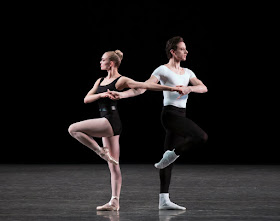
Lydia Wellington and Andrew Scordato in The Four Temperaments, New York City Ballet (photo by Paul Kolnik)
The second program of the New York City Ballet's visit to the Kennedy Center Opera House was not as marvelous as the first. The formula was the same as the first program: classic Balanchine paired with new works by the company's best young choreographers.
The Balanchine was a choreography long on my wish list, The Four Temperaments, the best known of the ballet scores composed by Paul Hindemith. The composer is not one most people think of as a dance composer, but his music worked exceptionally well in this collaboration with Balanchine from 1946. The music is in the form of a theme and variations, perhaps the musical structure best suited to ballet dancing because it provides variety in discrete sections. Balanchine created dances, mostly pairings and small groups costumed in domino-like black and white on a bare stage, that went with each of the temperaments in the score.
In the theme, Lydia Wellington and Andrew Scordato set the tone in a stiff and formal way, a vocabulary of movements that seemed mostly geometric but coordinated with and inspired by the music in the most natural way. The second pairing (Lauren King and Devin Alberda) entered with the piano solo, played expressively by Stephen Gosling in the pit, with King's foot kicks accenting flourishes from the keyboard. The third pair of the theme section (Ashley Laracey and Aaron Sanz) entered in a more deliberate set of movements that went with a fine violin solo section, one of the highlights of the choreography, with gorgeous form from Laracey, ending on her being carried off with her legs at a right angle.
Gonzalo Garcia flung himself around in the Melancholic variation, followed by two women who flitted around him in agitation. When joined by four more dancers, the moves became slower and heavier, with repeated gestures weighing down the movement in the style of the music. The Sanguinic variation was marked by enthusiastic high kicks in the entrance of Sara Mearns and Jared Angle. When four women joined Mearns in an active, decisive dance, the black one-piece costumes made them look almost like a synchronized swim team. Solo dancer Ask La Cour was measured and balanced in the Phlegmatic variation, each advance forward matched by a solemn retreat, later shadowed by four women in one of the other highlights of the ballet. Teresa Reichlen, her tall and lithe form all points and edges, led the Choleric section through Balanchine's calculated addition of dancers to involve the whole cast in a climactic final scene.
Sarah L. Kaufman, From New York City Ballet: Big music, big dancing (mostly) (Washington Post, June 9) Alastair Macaulay, Sign of the Times: City Ballet’s Ashly Isaacs Laces Up Her Sneakers (New York Times, May 10) ---, New York City Ballet Opens a Spring Gala, and Some Umbrellas (New York Times, May 5) ---, New York City Ballet’s Very 21st-Century Steps (New York Times, January 27) |
Justin Peck's The Times Are Racing, premiered this past January, is a mixture of ballet and many other dance forms, including tap, breakdancing, hip-hop, Broadway, and tap. A mass of dancers, dressed in tennis shoes, T-shirts (some marked with the word "DEFY"), jeans, and other street clothes (costumes by Humberto Leon) pulsated to the recorded electronic music of Dan Deacon (the last four tracks from his album America), played through the theater's speakers at ear-piercing volume. The choreography is a tour de force of frenetic action and irrepressible energy, never seeming to slacken its pace for over twenty minutes, and it captures the seething rage, mostly about political realities in the United States, of the music.
The performance also offered another chance to see the choreographer in action as a dancer, because he stepped in to replace Ashly Isaacs in the second pairing of this ballet. Peck's dances with Taylor Stanley were a highlight, but in the closing sections of the ballet Peck's choreography began to repeat itself a lot, as if filling out the time of the final track. It is a brash, bracing work that captures the bristling anger and frustration of the country at this moment, but it felt uneven.
This program repeats this afternoon in the Kennedy Center Opera House.
No comments:
Post a Comment